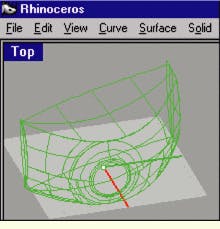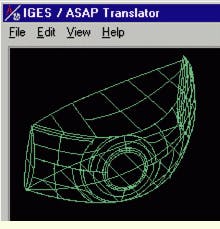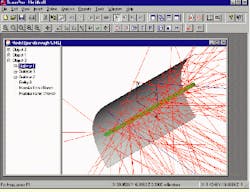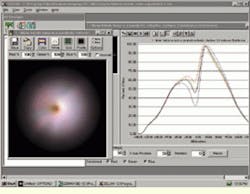MODULAR SOFTWARE TOOLS OFFER optics and lens designers GREATER VERSATILITY
MODULAR SOFTWARE TOOLS OFFER optics and lens designers GREATER VERSATILITY
By Andrew Wilson, Editor at Large
In the design of many image-processing systems, off-the-shelf optics and lenses cannot be used. Instead, system developers must design customized optics to meet their vision-system requirements. To aid this process, several companies are now
offering modular software packages that ease the burden of designing, analyzing, and prototyping optical systems. In addition, these modular packages can be combined with other computer-aided-design (CAD) software to design, analyze, optimize, and visualize optical systems as three-dimensional (3-D) models.
In offering modular solutions, software vendors have opted to provide optical-design packages as a series of tools that can be selected, if and when required, by system developers. Whereas an initial software choice might be to model, optimize, or analyze an optical system, other software options provide models of industry-standard light sources, libraries of lens-design examples, and CAD tools for virtual 3-D photometric simulation.
At the initial stages of a typical optical design, several design trade-offs are usually made. These generally include the number and types of elements required, the weight of the system, and system overall size. Fortunately, several graphical-user-interface (GUI) based software packages are available that allow system developers to create a variety of geometric surfaces and objects, design lenses, or manipulate and define different reflective, transmitting, and surface coatings. For example, with the Code V package from Optical Research Associates (Pasadena, CA), system developers can choose from a variety of surface types including diffraction gratings, generalized aspheric surfaces, and holographic surfaces. In addition, user-defined surface types can be created, allowing optimization and analysis of surface types not available in the program.
Cutting development time
Because many optical designs can be developed from existing models, several software packages offer libraries of preconfigured optical designs. They provide developers with a starting point for new optical systems and can reduce the development times of new designs. Often, these libraries can be directly imported into optical-design packages and manipulated by adjusting the design parameters of the optical elements.
Perhaps the most comprehensive database of optical designs can be found in the LensVIEW optical-design database, a searchable CD-ROM of more than 21,000 different designs from Optical Data Solutions (New York, NY). As an option for the Zemax lens-design program from distributor Focus Software (Tucson, AZ), LensVIEW is a database of many optical designs found in the United States and Japanese patent literature. Using a search engine, developers can look through more than 5000 patents with more than 21,000 design examples and more than 34,000 systems using queries that include numerical aperture, field of view, magnification, and number of elements. To manipulate the optical design, the lens file can be loaded into Zemax, where it can be manipulated and modified.
Other manufacturers, such as Optical Research Associates and Kidger Optics (Crowborough, Sussex, England), also offer libraries to aid in the design of optical systems. As part of its Code V package, Optical Research Associates offers a library of 2400 lens modules from patents and other sources. Similarly, the Lens Solution Module, part of the Sigma 2100 optical-design software from Kidger Optics, provides developers with 260 ready-made solutions for wide-angle, zoom, and fish-eye lenses.
Optimizing designs
Using off-the-shelf optical-design packages, such as Zemax and Code V, developers can select variables such as optical curvature, lens thickness, and indexes of refraction for their optical systems. Once these variables have been determined, merit (or error) functions that determine the optical quality of the system and constraints that may restrict possible configurations can be set. Then, software packages can alter these variables while attempting to minimize the error functions.
Such optimization functions are the features of many off-the shelf packages, including Zemax from Focus Software, Code V from Optical Research Associates, and Sigma 2100 from Kidger Optics. In the Zemax package, two global optimization algorithms are used. The first, called global search, is used to seek out new designs and optimize them as the ten best designs available. The second algorithm, called Hammer optimization, searches for a better variation of the current design. Hammer optimization is used in the final stages of a design to verify that the best possible design has been selected.
In the Code V package, global optimization software called Global Synthesis allows optical designs with up to 100 variables and dozens of hard constraints to be improved. This software provides multiple, different, locally optimized solutions, each meeting all of the constraints imposed.
To set the merit functions in the Sigma 2100 package, a submenu allows developers to optimize the optical system as a camera, collimator, binocular, microscope objective, or copier lens. The system then chooses a set of default parameters that can be altered by the developer. In addition, the program allows analysis windows to be viewed in real time during optimization so that the developer can view the optimization process in progress.
CAD programs
In many optical designs, the components of the optical system, such as lenses, mirrors, and prisms, must be represented in the same model and environment as the mechanical components and structures. To accomplish this, many software vendors offer CAD-like packages with their optical-design software to simulate the effects of both the optical and the mechanical elements of the optical system.
Using such packages, developers can combine geometric shapes such as cylinders, spheres, and cones with each other or with optical elements. Therefore, system developers can create entire representations of the optical system and perform analysis using ray-tracing, reflection, refraction, and illumination modeling.
Manufacturers of optical-design packages are taking two approaches to provide designers with access to 3-D modeling techniques. While some companies have developed their own optical CAD software, others have chosen to bundle their optical-design packages with third-party CAD packages.
Rather than bundle its Code V optical-design package with an off-the-shelf CAD package, Optical Research Associates has developed its own package called LightTools, a 3-D solid modeler that can be used to represent both optical components and mechanical structures. In use, developers can combine the diffraction analysis, optimization, and tolerancing of optical systems found in Code V with the ray-tracing and visualization capabilities of LightTools.
Offering special optical and illumination analysis features and full optical accuracy, LightTools allows developers to account for all light paths including splitters, scattering, and multiorder diffraction in a physically realistic manner. Whereas ray-tracing can be used to perform stray-light analysis, the LightTools illumination module provides Monte Carlo simulation of illumination systems with user-defined sources and receivers. For compatibility with other CAD programs, optional data-exchange modules support import/export of Standard for Exchange of Product Model Data (STEP) and Initial Graphics Exchange Specification (IGES) CAD formats.
Breault Research (Tucson, AZ) and Focus Software have taken a different approach in their CAD offerings, choosing instead to bundle third-party CAD packages with their optical-design packages. While Focus Software is offering the OptiCAD package from Opticad (Santa Fe, NM) with its Zemax package, Breault has chosen to integrate the Rhino 3-D surface modeler from Robert McNeel and Associates (Seattle, WA) with its ASAP optical engineering software.
As an optical-system modeling program, OptiCAD can analyze arbitrarily placed optical components and can perform ray-tracing, reflection, refraction, scattering, and illumination modeling (see Fig. 1). Supporting lenses, mirrors, light pipes, prisms, gratings, and gradient index media, OptiCAD allows sources to be modeled as points, lines, volumes, and surfaces as refractive, reflective, diffuse, or specular. Using the CAD package, arbitrary shapes can be created and entire system models produced and modified using either macros or pull-down menus. For compatibility with Zemax, the CAD package can translate and incorporate lens designs from Zemax for further manipulation or analysis.
Bundled with Breault`s ASAP optical engineering software, the Rhino CAD package from Robert McNeel and Associates is a conceptual design and modeling tool that allows developers to create, edit, and render combinations of freeform curves, surfaces, and solids (see Fig. 2). Because Rhino objects are represented by smooth nonuniform rational B-splines (NURBS) rather than line segments or polygon meshes, curved shapes can be accurately represented. Solids can then be created, exploded into surfaces, edited, and then joined together again.
Third-party packages
Developers using Zemax and other design packages are not limited when it comes to the analysis of their optical designs. Lambda Research (Littleton, MA) also offers a ray-tracing program for illumination, optical, radiometry, and photometry analysis called TracePro. This program can import lens-design data from Code V, Oslo, Sigma, Zemax and Accos V from Optikos (Cambridge, MA) to create solid models of lenses with no loss of fidelity.
Claimed to be the first optics software based on the ACIS solid modeling kernel from Spatial Technology (Boulder, CO), the TracePro software combines solid modeling with optical analysis features and can determine both distributions and intensities of light in an optical design (see Fig. 3). Running under Windows 95/NT, TracePro allows developers to create objects within TracePro or build a solid model by importing data from a CAD program or a lens-design program.
Because TracePro is based on ACIS, any shape defined in a solid-modeling program can be ray-traced in TracePro, including NURBS surfaces. TracePro shares the ACIS data format with other ACIS-based applications, allowing a smooth two-way exchange of solid-modeling data with packages such as AutoCAD from Autodesk (San Rafael, CA), for example. ©
Although optical and CAD programs are helping developers build more sophisticated optical systems, the illumination sources for optical systems can be crucial to the optical design. Fortunately, CAD packages, such as Radiant Source Models written by Radiant Imaging (Duvall, WA), are addressing this problem by allowing developers to model, design, and analyze optical systems using actual lamps, LEDs, or other light sources.
By using hundreds of calibrated images of actual light sources taken from all possible viewing angles to generate appropriate rays to trace through the optical system, the sources in Radiant Imaging`s package provide a model for the light source that is more accurate than traditional approximations. With the correct ray set generated for the chosen source, Radiant Imaging`s package can use Zelum from Focus Software to trace the rays, allowing illuminance, irradiance, luminous intensity, or radiant intensity data to be generated at any surface in the optical system (see Fig. 4).
Because these Radiant Source models include measured data of such sources as metal halide, tungsten halogen, xenon, and LEDs, the measured data capture the full spatial and angular distribution of that particular source. Other software that can be used with the Radiant Sources package include ASAP, Olso, and TracePro.
With several off-the-shelf optical and CAD packages to choose from, developers can now rapidly design and prototype optical systems. And with many packages providing interoperability, developers can choose third-party packages with which to better optimize their designs. In choosing such packages, developers should carefully weigh their libraries, optimization functions, CAD features, third-party packages, and interoperability features. In doing so, they can substantially reduce the time to market and the cost of optical systems.
FIGURE 1. By bundling OptiCAD with its Zemax optical-design software, Focus Software allows optical systems developers to trace rays through arbitrary complex parts that typical lens-design codes cannot handle. Here, an injection-molded plastic part has been created by a CAD program and imported into OptiCAD.
FIGURE 2. As part of the ASAP CAD 6.0 package from Breault Research, the Rhino 3-D surface/solid modeler allows developers to build models in Rhino (left) and import the IGES files to ASAP with an integrated IGES file translator (right). Then, the IGES file can be imported to ASAP and assigned optical properties, names, and colors (bottom).
FIGURE 3. Using the graphical interface of TracePro from Lambda Research, a parabolic trough reflector has been built, properties have been applied to both the cylindrical source and reflector surface, and the system has been ray-traced with 10,000 rays.
FIGURE 4. Radiant Source Models from Radiant Imaging allow developers to model, design, and analyze optical systems, such as projectors or condenser lenses, using actual lamps, LEDs, or other light sources. In this example, the illuminance from a metal halide lamp is shown reflected off a hyperbolic mirror. The brown region in the center is caused by color separation in the lamp.






